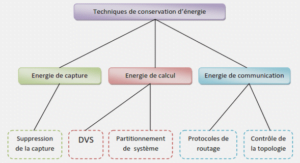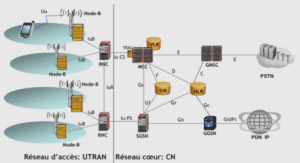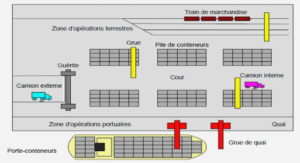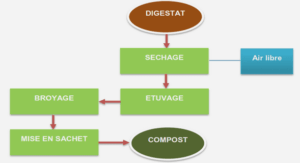METHODOLOGICAL APPROACH
STUDY AREA
The study area covers approximately 10 000 km2 at the transition between northern temperate and boreal forest in Quebec, Canada (48°25’N 71°04’W). The region is characterized by hills that rarely exceed 500 m, on thick and undifferentiated glacial till deposits. This area is part of balsam fir-white birch, balsam fir-yellow birch, and spruce-moss bioclimatic domain (Figure 1). The climate is continental and has a short warm summer, without a dry season. The 30-year mean annual temperature is 2.8° C and total precipitation of 930 mm, with 5-month covert by snow (Government of Canada 2017).
TREE SELECTION
The infested areas was assessed using the spruce budworm annual aerial detection survey data from the government of Quebec (MFFP 2016; 2017). In order to delimit the sampling area, some factors were considered, such as: public lands that were not harvested in the last years, stands defoliated between one to four years of defoliation, stands within 150 kilometers from the Lake Saint-Jean. Finally, twenty natural stands dominated by balsam fir (Abies balsamea (L.) Mill.) and twenty-one dominated by black spruce (Picea mariana (Mill.)) were selected. At each site, representative defoliated individuals were chosen randomly among healthy trees. A visually assessment of the defoliation was made with binoculars before harvesting. The trees were sampled in the summers of 2016 and 2017 (June and early July).
Stands were divided according to the duration of defoliation in five classes: from no defoliation to up to four continuous years of defoliation. D0 represents control trees without defoliation, D4 four years of consecutive defoliation. D1, D2, and D3 represent one to three years of continuous defoliation. Additionally, a visual assessment of defoliation intensity was carried out for each sampled tree in the field. Three intensities of defoliation were used: light (25% needle loss), moderate (from 26% to 70% needle loss), and severe (more than 71% needle loss). Thus, the goal of this study is understand the combined effects of timing and intensity of defoliation in each parameter, where each defoliation class represents the duration of consecutive defoliation, and intensity of defoliation, the degree of needle loss. Preliminary analysis showed more variation in the data between the trees with a longer defoliation lasting. For this reason, the number of harvested trees varied between the defoliation classes, with more trees to a longer defoliation period (Table 1).
Stand characterization was done including information and measurements of stand composition, slope, drainage, and soil type. Height, diameter at breast height (DBH) and crown length were also measured on 15 live trees (si) (Table 1). Soil profiles were classified into three broad categories: well drained (64 % of the study sites), moderately (20 %) and poorly drained (16 %). Two types of soils were found: podzolic (73 %) and organic soils (23 %). Tree age ranged from 24- to 132-year-old for the balsam fir and 29- to 172-year-old for black spruce stands (Table 1).
A total of 119 black spruces and 119 balsam firs were harvested (Table 1). Five stem discs were collected from each tree, located at tree base (0m), DBH (1.30m), 25%, 50%, 75% tree height.
MEASUREMENTS
Age and Growth estimation
A standard method was used to archive dendrochronological data (Stokes 1968); discs were cut in half, air-dried and transversal surface cut or sanded (Figure 6). Tree-ring widths were measured to an accuracy of 0.01 mm using a WinDendro measuring system (Régent Instruments Inc 2011) along two paths per disc. Crossdating was performed visually and by using the COFECHA computer program for the discs at 0 m (Holmes 1983).
To standardize the data, radial growth in the defoliated and control trees was evaluated based on the average of the growth in the last 20 years, for the respective height and defoliation class. The ring width index was calculated as follows:
To assess the growth response to defoliation, the current (CAI) and periodic (PAI) annual volume increments were assessed for each tree 15 years prior to the outbreak. The volume of a tree for one particular year was estimated as the sum of the volumes of cone sections delimited by two consecutive discs whose diameters were calculated from a quadratic mean of two radii. A linear equation of the form y1=ax1 + b was used to express the relationship between the CAI of the stem before the infestation and the age of each defoliated tree. The mean correlation coefficient of these equations was 0.92 for black spruce and 0.95 for balsam fir. Theoretical growth (without infestation) was assessed by extrapolating this equation and the growth loss was obtained by subtracting observed growth from theoretical growth (Archambault 1983). In order to minimize the probability of overestimating the theoretical increment, only trees that had not reached their maximum current annual increment in volume were used in the analysis. Furthermore, trees with equation correlation lower than 0.85 were disregarded.
Wood density and Anatomical features
Wood density and anatomical measurements are time-consuming, we limited these analyses to trees with three and four years of consecutive defoliation. Furthermore, eighty breast height discs (40 fir and 40 spruce trees) were randomly chosen from 137 discs sampled. Strips of 1.63 mm thick (longitudinal) and 25 mm wide (tangential) were obtained from radial segments (Figure 6). The strips were dried to 12% moisture content and measurements were made from bark to pith at intervals of two mm, using an X-ray densitometer available at Université Laval, Quebec City, Canada. The transition from early- to late-wood within a ring was defined as the point where the maximum change in density was reached (Mothe et al. 1998; Lemay et al. 2016). Earlywood, latewood, and average ring density were measured for every annual ring of each sample. Only the data from the 11 years prior to the defoliation until the last year of defoliation were kept for the analyses.
The same eighty discs were used for the wood anatomical analyses. Wood samples containing the last five annual rings were collected. The samples were embedded in paraffin (Leica TP1020), cut into sections of 7μm with a rotary microtome (Leica RM2145), fixed on slides, and stained with an aqueous solution of 1% safranin. A camera fixed on an optical microscope was used to record numerical images at a magnification of 20×. Lumen area, cell wall thickness, cell width, and cell numbers were measured in each ring on three radial files per ring using Wincell v.2010 (Deslauriers et al. 2003).
STATISTICAL ANALYSES
All statistical analyses were performed using the software SAS, version 9.4 (SAS Institute Inc. 2013). The MIXED procedure in SAS was used, with the estimation of the restricted maximum likelihood, and the “UN” covariance structure was applied to the model. For the growth analysis, mixed-models were performed to test for differences in growth between individual years of defoliation (2013-2016), the eleven years prior to defoliation (2002-2012) and the last fifteen years in non-defoliated control trees (2002-2016). Individual years had to be significantly different from both, control and non-defoliated periods, to reject the null hypothesis. The following fixed effect factors were used in the mixed-models: defoliation class (D), intensity of defoliation (IN), year of the growth ring, the respective year of defoliation during the formation of growth ring (Y), and the stem height (H) for ring width index. When the interaction term defoliation class (D) × Year of Defoliation (Y) was found significant, the SLICE option of the LSMEANS statement was used. This statement allowed to identify in the cumulative period of defoliation which years differed between the control and defoliated trees.
The same mixed-models were performed for wood density and anatomical properties. However, the control period used was only the eleven years prior to defoliation (2002-2012) for wood density and the last year before defoliation (2012) for anatomical analysis. Because only trees with more than 3 years of cumulative defoliation were used, the defoliation class effect was no more used. The SLICE option of the LSMEANS statement was also performed to identify the years (Y) and the intensities (IN) that differed between the control and treated trees.
Data were log-transformed when necessary to meet the normality and homoscedasticity assumptions. Differences between mean values were considered significant when the p-value was <0.05.
RESULTS
RING WIDTH
There was a clear negative effect of the defoliation on growth (Figure 7). Comparing the pre-outbreak period with the post-outbreak, 95 % of the defoliated black spruce trees showed a radial growth decrease after defoliation on the average of the four measured heights, whereas this percentage was nearly 90 % for balsam fir trees. For black spruce, there was a mean radial growth loss of 34 % (maximum 78 % loss) while balsam firs had an average of 31 % (maximum 83 % loss).
In the pre-outbreak period, the ring width index of the four heights was similar to that of the control trees for both species (statistical analysis not shown) but a decreasing nonsignificant trend was observed after each consecutive year of defoliation for balsam fir, and significant for Black spruce in all D3 class (Table 8A, Figure 7). The decrease in ring width on the average of the four heights was, respectively, 22, 39, 36, and 33 % from the period of one to four years of consecutive defoliation for black spruce and 31, 18, 40, 28 % for balsam fir.
By looking at the defoliation intensity of black spruce, the second year of defoliation was significantly lower in the moderate and severe intensities in the defoliation class D2. In D3, the severe defoliation intensity was different from control trees from the first until the third year of defoliation; for the last year, the three defoliation intensities presented differences among them. In D4, only the severely defoliated trees were significantly lower in the third and fourth year compared to control trees (Figure 8).
MEAN ANNUAL INCREMENT VOLUME (MAI)
There was a visible negative effect of defoliation duration in the mean annual volume increment between defoliated and control trees for both species (Figure 10). Defoliated black spruce trees had a significant volume loss of 13, 27, 39, and 46 % respectively, from the first to the fourth year of defoliation compared to control trees. Annual increment volume decreased significantly for balsam fir trees with losses of 10, 20, 34, and 38 % for the same period. All the years showed a significant difference between control and defoliated trees, except the first year in D4 defoliation class for balsam fir (Figure 10). The evaluated intensity of defoliation for all defoliation classes was not significant for either species compared to control trees (Table 8B).
WOOD DENSITY
Only trees defoliated for three and four years were analyzed for wood density and cellular features. Comparing the pre-outbreak period (2002-2012) with the last 4-year post-outbreak period (2013-2016) showed that black spruce presented clearly higher wood densities and slightly higher cumulative changes than balsam fir (Figure 11). Despite this pattern, the outbreak period did not affect latewood proportion and earlywood density in either species (Table 8C,E, Figure 11A,C). For the ring density, a decreasing trend was observed for black spruce in the outbreak period, with significant changes only after four years of defoliation, and no changes were calculated for balsam fir (Table 8D, Figure 11B).
In black spruce, latewood density continuously decreased over the defoliation period from years one to three, with significant values for the second and third years of defoliation (Table 8F, Figure 11D). Balsam fir showed a decrease over the entire period, with significant reductions in the third and fourth years of defoliation (Table 8F, Figure 11D). The defoliation intensities affected only balsam firs in latewood density for severely defoliated trees (Table 8F).
ANATOMICAL FEATURES
Figure 12 shows the lumen area, mean cell wall thickness, radial cell width, and number of xylem cells in early and latewood for 2012, the year before the defoliation, and the consecutive defoliation period (2013-2016). For all the anatomical features balsam fir showed higher values than black spruce, however, the changes observed were quite similar during the outbreak period for both. In lumen area, both species demonstrated the same pattern, an increasing trend in earlywood and decreasing in latewood. Balsam fir showed significant differences (Table 9A,E, Figure 12A) in earlywood, however statistical analyses could not pinpoint a single year and the defoliation intensity where it was different, and in latewood the differences period was found in the first, third and four years of defoliation.
A significant decreasing trend in latewood for all the defoliation period for black spruce and only after three years of consecutive defoliation for balsam fir was detected in cell wall thickness and cell width (Table 9F,G, Figure 12B,C). In earlywood, the two species presented significant differences only after three years of consecutive defoliation (Table 9B,C), but with different patterns. The defoliation period tends to decrease the cell wall and cell width in black spruce, while balsam fir does not have a stable pattern in cell wall thickness and a slight increasing trend for cell width (Figure 12B,C). The cell number also decrease significantly with the increase of duration of defoliation for both species in early and latewood (Table 9D,H, Figure 12D). The defoliation intensities affect balsam fir in early and latewood and black spruce only in latewood for cell wall thickness (Table 9C,E,F, Figure 13).
DISCUSSION
GROWTH RESPONSE
Results confirmed that growth losses are a function of the duration of the defoliation for black spruce and balsam fir. Spruce budworm defoliation affects annual ring width, to the point that volume increment of affected trees is also impacted. In our study, balsam fir presented on average 31% of the loss of growth in volume after a four-year defoliation period and black spruce 34%. Several studies have already shown a reduced growth response following sustained defoliation over a few years by the spruce budworm (Archambault 1983; Krause et Morin 1995a; Krause et al. 2012) or with other types of insect pests outbreaks in North America (Alfaro et al. 1985; MacLean 1985; Hennigar et al. 2008).
Generally, significant volume losses were observed for balsam fir and black spruce following the first year of defoliation (Figure 10). This immediate growth response to defoliation of current year’s foliage was also observed for Piene (1980) and Pothier et al. (2005) in balsam fir stands defoliated by spruce budworm. However, a lag of 1 to 3 years between the beginning of defoliation and the appearance of the loss of volume growth has been also described for balsam fir and black spruce stands (Archambault 1983; Krause et al. 2003; Krause et al. 2012) and other species defoliated by insects outbreaks (Stark et Cook 1957; Axelson et al. 2014). These differences in the synchronous of defoliation and growth loss probably reflect an inherent imprecision of the defoliation map surveys used to detect the onset of defoliation (Krause et al. 2003; Pothier 2012). Differences of tree size and defoliation intensity have been also described as major factors, which could influence the growth and lag response of plants to defoliation (MacLean 1980; Alfaro et al. 1985; Rossi et al. 2009).
Two opposite observations of growth reduction caused by spruce budworm have been also described: one stating that growth loss occurs throughout the entire stem in the same year (Blais 1958; Piene 1980) and the other reported a growth loss starts in the upper crown and a delay at the base of the stem (Piene et al. 1989; Krause et Morin 1995b). In New Brunswick and more southern areas with longer growing seasons, where the defoliation occurs over a longer period, Krause et al. (2003) observed in balsam fir stands that the delay between defoliation and growth loss was variable depending upon stand age. In immature trees, ring reduction occurred simultaneously along the entire stem, whereas in mature trees, the growth reduction occurred one to three years earlier in the crown than at the stem base. The tree-ring widths in our study exhibited a synchronous decrease along the whole stem for both species, independently of stand age.
Further, it is interesting to note that the volume loss was more important for black spruce than for balsam fir in this study. In the past spruce budworm outbreaks, many studies showed a decreased growth after defoliation for both species, however balsam fir was the most vulnerable specie (Blais 1958; MacLean 1984; MacLean et MacKinnon 1997). These results may suggest that, in the current epidemic period, black spruce could be as impacted as balsam fir was in the last outbreak.
|
Table des matières
LISTE DES TABLEAUX
LISTE DES FIGURES
LISTE DES ABRÉVIATIONS
REMERCIEMENTS
INTRODUCTION
CHAPOTRE1:POTENTIEL ET ÉTAT HYDRIQUE DES ARBRES DÉFOLIÉS PAR LA TBE ET LEUR INFLUENCE SUR LE TAUX D’HUMIDITÉ ET LA PROPORTION D’AUBIER
1.1 INTRODUCTION
1.2 METHODOLOGICAL APPROACH
1.2.1 STUDY AREA
1.2.2 TREE SELECTION
1.2.3 MEASUREMENTS
1.2.4 STATISTICAL ANALYSES
1.3 RESULTS
1.3.1 RELATIVE WATER CONTENT AND WATER POTENTIAL
1.3.2 MOISTURE CONTENT
1.3.3 SAPWOOD AND HEARTWOOD RATIO
1.4 DISCUSSION
1.4.1 RELATIVE WATER CONTENT AND WATER POTENTIAL
1.4.2 SAPWOOD AND HEARTWOOD: MC AND AREA RATIO
1.5 CONCLUSION
CHAPITRE 2: ÉVALUATION DE QUELQUES PARAMÈTRES DE LA QUALITÉ DU BOIS AFFECTÉ PAR L’ÉPIDÉMIE DE LA TBE
2.1 INTRODUCTION
2.2 METHODOLOGICAL APPROACH
2.2.1 STUDY AREA
2.2.2 TREE SELECTION
2.2.3 MEASUREMENTS
2.2.4 STATISTICAL ANALYSES
2.3 RESULTS
2.3.1 RING WIDTH
2.3.2 MEAN ANNUAL INCREMENT VOLUME (MAI)
2.3.3 WOOD DENSITY
2.3.4 ANATOMICAL FEATURES
2.4 DISCUSSION
2.4.1 GROWTH RESPONSE
2.4.2 WOOD PROPERTIES OF BALSAM FIR X BLACK SPRUCE BEFORE DEFOLIATION
2.4.3 WOOD PROPERTIES OF BALSAM FIR X BLACK SPRUCE AFTER DEFOLIATION
2.4.4 REDUCTIONS IN WOOD GROWTH X WOOD QUALITY
2.5 CONCLUSIONS
CONCLUSIONS ET IMPLICATIONS
BIBLIOGRAPHIE
![]() Télécharger le rapport complet
Télécharger le rapport complet






